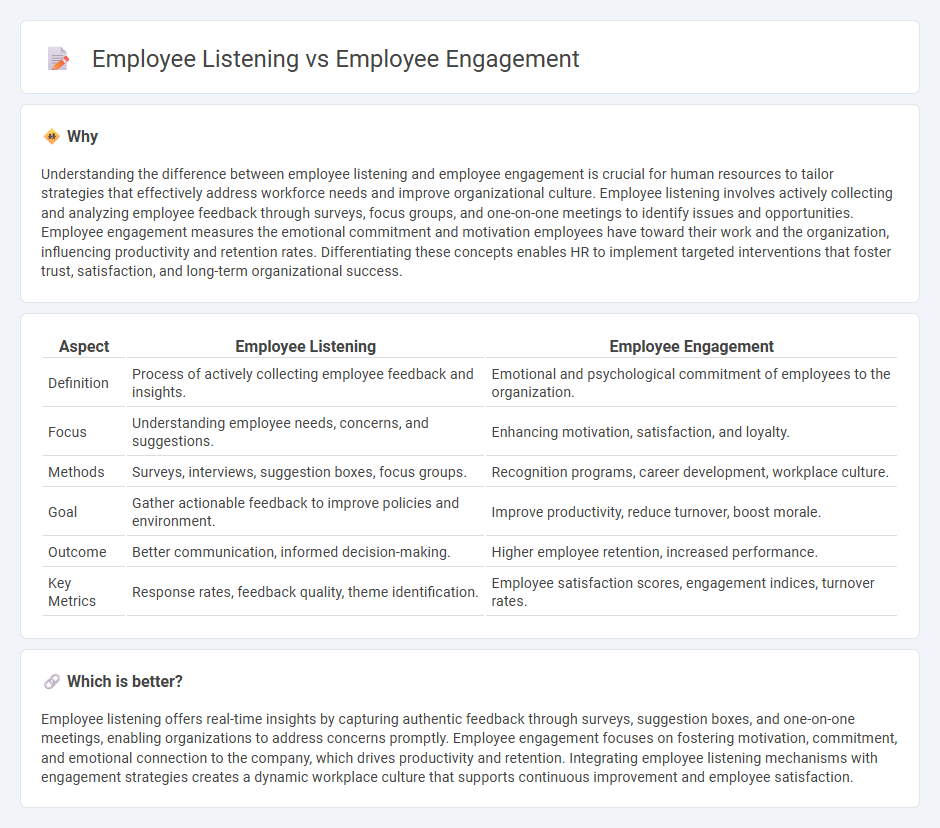
Employee listening involves collecting and analyzing employee feedback through surveys, focus groups, and direct conversations to understand workforce sentiments and needs. Employee engagement refers to the emotional commitment and motivation employees have toward their organization, often influenced by effective listening practices. Discover how integrating employee listening strategies can elevate overall engagement and drive organizational success.
Why it is important
Understanding the difference between employee listening and employee engagement is crucial for human resources to tailor strategies that effectively address workforce needs and improve organizational culture. Employee listening involves actively collecting and analyzing employee feedback through surveys, focus groups, and one-on-one meetings to identify issues and opportunities. Employee engagement measures the emotional commitment and motivation employees have toward their work and the organization, influencing productivity and retention rates. Differentiating these concepts enables HR to implement targeted interventions that foster trust, satisfaction, and long-term organizational success.
Comparison Table
| Aspect | Employee Listening | Employee Engagement |
|---|---|---|
| Definition | Process of actively collecting employee feedback and insights. | Emotional and psychological commitment of employees to the organization. |
| Focus | Understanding employee needs, concerns, and suggestions. | Enhancing motivation, satisfaction, and loyalty. |
| Methods | Surveys, interviews, suggestion boxes, focus groups. | Recognition programs, career development, workplace culture. |
| Goal | Gather actionable feedback to improve policies and environment. | Improve productivity, reduce turnover, boost morale. |
| Outcome | Better communication, informed decision-making. | Higher employee retention, increased performance. |
| Key Metrics | Response rates, feedback quality, theme identification. | Employee satisfaction scores, engagement indices, turnover rates. |
Which is better?
Employee listening offers real-time insights by capturing authentic feedback through surveys, suggestion boxes, and one-on-one meetings, enabling organizations to address concerns promptly. Employee engagement focuses on fostering motivation, commitment, and emotional connection to the company, which drives productivity and retention. Integrating employee listening mechanisms with engagement strategies creates a dynamic workplace culture that supports continuous improvement and employee satisfaction.
Connection
Employee listening enhances employee engagement by fostering open communication channels that capture worker feedback and concerns, leading to increased trust and motivation. Active listening practices enable Human Resources teams to identify and address workplace issues promptly, driving higher job satisfaction and productivity. This connection underscores the strategic role of employee listening in cultivating a committed and engaged workforce.
Key Terms
Employee Engagement: Motivation, Commitment, Productivity
Employee engagement centers on fostering motivation, commitment, and productivity within the workforce, driving employees to invest effort and remain dedicated to organizational goals. Unlike employee listening, which primarily focuses on gathering feedback to improve workplace conditions, engagement actively cultivates emotional and intellectual investment in the company's success. Explore effective strategies to boost employee engagement and transform organizational performance.
Employee Listening: Feedback, Surveys, Voice
Employee listening centers on capturing and analyzing employee feedback through structured surveys, informal conversations, and open communication channels to genuinely understand workforce sentiments. This approach empowers organizations to identify concerns, measure satisfaction, and implement targeted improvements in real time. Discover how effective employee listening strategies can transform engagement and drive business performance.
**Employee Engagement:**
Employee engagement measures the emotional commitment and motivation employees have towards their work and organization, directly impacting productivity and retention rates. It involves initiatives such as recognition programs, career development, and well-being support that foster a positive workplace culture. Discover strategies to boost employee engagement and transform your organizational performance.
Source and External Links
Why employee engagement is key to company success - Firstup - Employee engagement is a strategic business objective that leads to higher productivity (+18%), profitability (+23%), long-term retention, and reduced absenteeism (-78%) by fostering personalized communication, recognition, and a sense of belonging in the workplace.
How to Improve Employee Engagement in the Workplace - Gallup.com - Gallup defines employee engagement as the involvement and enthusiasm of employees and shows that highly engaged employees deliver better business outcomes like 23% higher profitability, 78% less absenteeism, and 63% fewer safety incidents, backed by decades of research across industries.
What is Employee Engagement? (And How to Boost It) - Employee engagement means employees feel valued and connected, resulting in 17% higher productivity, 41% lower absenteeism, stronger employer brand, better health, and greater trust in leadership, all driving both employee and organizational success.
 dowidth.com
dowidth.com